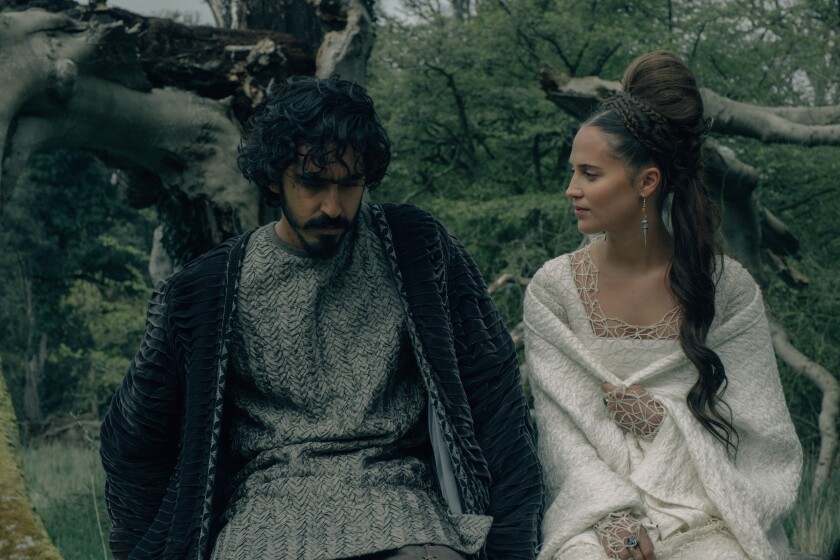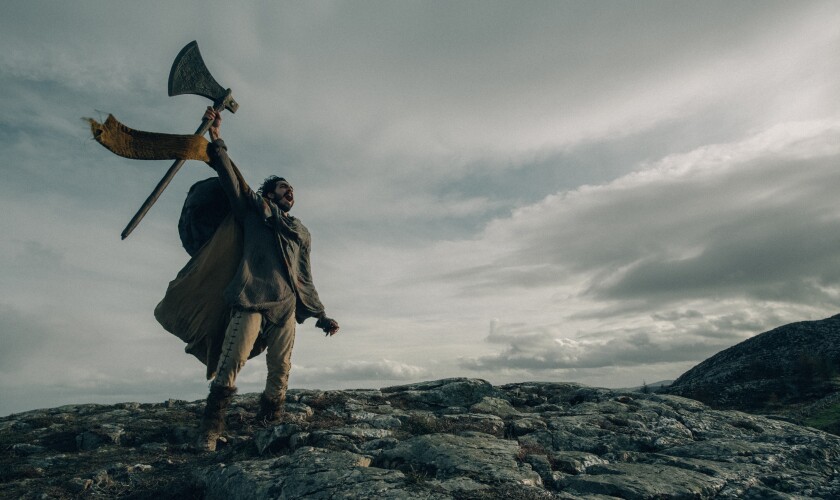Review: ‘The Green Knight,’ with Dev Patel as an Arthurian adventurer, is a ravishing triumph
The Times is committed to reviewing theatrical film releases during the COVID-19 pandemic. Because moviegoing carries risks during this time, we remind readers to follow health and safety guidelines as outlined by the Centers for Disease Control and Prevention and local health officials.
“Remember: It is only a game.” Those words, more ominous than reassuring, are heard early in “The Green Knight,” David Lowery’s misty, melancholy dream of a medieval epic. They are spoken by King Arthur (Sean Harris) to his impetuous young nephew, Gawain (Dev Patel), who’s about to confront the challenge of his life. If this is indeed a game, the stakes are uncertain, the rules a mystery, the outcome far from assured. One way to approach this extraordinarily beautiful and hypnotic movie is to see it as another kind of game, one that Lowery is delighted to play with you and your expectations.
Those who’ve read “Sir Gawain and the Green Knight,” a 14th century poem of unknown authorship and vast influence, will come to Lowery’s film with their own preconceptions. So will those who’ve seen their share of Arthurian screen epics, a mixed lineage that ranges from the lush Wagnerian grandeur of John Boorman’s “Excalibur” to the bold demystifications of Robert Bresson’s “Lancelot du Lac.” “The Green Knight” isn’t a radical departure from these forebears; by turns ravishing and austere, scholarly and accessible, earthy and exalted, it seems to have absorbed its many influences and alchemized them into something vital and singular. It’s a bewitching feat of revisionist mythmaking, the kind that implores you to look upon an old story with newly appreciative eyes.
The importance of seeing clearly, of peering into oneself and the larger world with depth and discernment, is at the heart of a story marked by its own peculiar intensity of vision. (Andrew Droz Palermo composed the film’s exquisite images; the intricate but never ostentatious sets and costumes were designed by Jade Healy and Malgosia Turzanska, respectively.) Tellingly, when we first meet Gawain, he’s being yanked out of a deep slumber, not for the last time in a movie that plays like a series of rude awakenings. The one rousing him this time is his lover, Essel (Alicia Vikander), in a brothel on Christmas morning. “Christ is born,” she says, and the invocation lingers; like so many Arthurian legends, “The Green Knight” bears witness as an old world of pagan rites gives way to a rising tide of Christian belief.
Gawain, whom Patel inhabits even more assuredly than he did David Copperfield, himself incarnates that religio-cultural tension. He is the nephew of King Arthur and Queen Guinevere (Kate Dickey) and a privileged guest at their Christmas celebration. But in one of a few key deviations from the original text, Gawain is also the son of the enchantress Morgan le Fay (Sarita Choudhury), whose determination to secure his future sets the story in motion. We see her cunning hand at work as Arthur’s Christmas festivities are interrupted by the Green Knight (Ralph Ineson), who turns up like the evil fairy crashing Sleeping Beauty’s christening.

Dev Patel and Alicia Vikander in the movie “The Green Knight.”
(Eric Zachanowich / A24 )
Evil, however, is not the name of this visitor’s game. Riding in on horseback and bearing aloft a leafy scepter, he’s an imposing Treebeard-like figure, but his eyes, gleaming out from a gnarled trunk of a face, carry more mischief than malice. (The Middle-earth echoes are fitting: J.R.R. Tolkien famously translated “Sir Gawain and the Green Knight” himself, and Weta Digital, known for its work on “The Lord of the Rings” trilogy, handled this movie’s beautifully spare visual effects.) The Green Knight challenges those present to a game, inviting anyone to strike him, on the condition that one year later they will reunite at the distant Green Chapel, where the challenger will be dealt the same blow in return. Gawain impulsively accepts, swings a sword and decapitates the Green Knight — who in turn rises from the floor, calmly retrieves his head and leaves, reminding Gawain that they will reunite in one year.
Before long that year is nearly spent, and Gawain, with a mighty ax in hand and a magically protective green sash tied around his waist, ventures forth to confront his uncertain destiny. Will he lose his head, or is the Green Knight’s bark worse than his smite? That’s just one question that lingers over this solemn hero’s quest, in which long stretches of solitude alternate with beguiling and sinister encounters. There are wily thieves and spectral maidens, wandering giants and a persistently friendly fox. The splendid supporting players include Barry Keoghan, Erin Kellyman, Helena Browne and Joel Edgerton, whose voice takes on a lovely, almost musical lilt in the role of a kindly lord who welcomes Gawain into a castle full of secrets.
Speaking of music: These fateful encounters draw lyricism and gravity from the singsong interludes and delicately plucked strings of Daniel Hart’s enveloping, ever-present score. They are also delineated by ornate chapter headings, one of a few structuring devices — a Punch and Judy show is another — that can feel both immersive and distancing: classical touches infused with an arch modern playfulness. Lowery plays with proximity and distance throughout; we are close beside Gawain at some moments and far away from him at others, as he stands dwarfed by fog-draped mountains and moss-covered forests. Sometimes we are peering down at him from a God’s-eye view — or perhaps the perspective of someone examining a beautifully embroidered tapestry, or the moving pieces on a game board.
The game advances, and with it a test of wits and mettle, chivalry and courage — the kind that every knight aspirant must endure and master. Gawain’s progress is doggedly linear but also curiously circular. His prized possessions have a way of getting lost and then finding their way back to him. Mysterious doublings recur throughout the narrative: a painting, a woman’s face, a(nother) severed head. At times the camera rotates slowly on its axis, a movement that seems to accelerate — and even boldly reverse — the passage of time itself. And in ways both unsettling and oddly reassuring, each of Gawain’s adventures seems to hark back to that original Christmas Day challenge.

Dev Patel in the movie “The Green Knight.”
(Eric Zachanowich / A24)
With each new encounter, an exchange of favors is requested, though not always achieved. The moral implications of each exchange will reverberate through the story, cutting to the heart of what turns out to be, for Gawain, an epic quest for purity and possible salvation. Why do we expect repayment for a gift, a favor, an act of kindness? What is the cost of withholding what someone is due — or, worse, of clinging to something we haven’t earned? Is Gawain really off to reunite with the Green Knight, or has the Green Knight perhaps been traveling with him all along, manifesting himself in a different form each time?
Lowery’s film teases out these riddles, some of which are as old as the text itself, but it’s finally too rich, mysterious and sensuous an experience to be confined by any of them. Its symbols and archetypes contain interpretive multitudes. The Green Knight himself is both a resurrected Christ figure and an avatar of the natural world — an imposing, sometimes confounding embodiment of pagan and Christian traditions. That duality finds even more forceful expression in Patel’s performance, which is by turns a wrenching study in spiritual torment, a sweatily charismatic star turn and a reminder that few things are sexier than repression. Not least among the things we’re invited to contemplate in this endlessly contemplative film is the beauty of its leading man.
The deliberation of Lowery’s gaze feels aesthetically indebted to any number of great spiritual epics: You might be reminded of the philosophical duel in Ingmar Bergman’s “The Seventh Seal” or the searing, searching passion play of Martin Scorsese’s “The Last Temptation of Christ.” But it also feels of a piece with Lowery’s own past work. At times Gawain’s journey echoes that of another alienated wanderer, the temporally unmoored protagonist of “A Ghost Story” — a title that could just as easily have applied to this movie, with its dark visions and strange spirits. The mystery that haunts Gawain is whether he is ready to cross over, and whether he will continue to deny his desires in the short time that may remain to him.
What does it mean to be a knight, or even just to be human? It isn’t an easy question, and “The Green Knight,” in taking it seriously, isn’t always an easy film. But by the time Gawain reaches his journey’s end, in as moving and majestically sustained a passage of pure cinema as I’ve seen this year, the moral arc of his journey has snapped into undeniable focus. He plays the game; he accepts the challenge. His example is worth following.
‘The Green Knight’
Rated: R, for violence, some sexuality and graphic nudity
Running time: 2 hours, 10 minutes
Playing: Starts July 30 in general release
appId : '134435029966155',
xfbml : true, version : 'v2.9' }); };
(function(d, s, id){ var js, fjs = d.getElementsByTagName(s)[0]; if (d.getElementById(id)) {return;} js = d.createElement(s); js.id = id; js.src = "https://connect.facebook.net/en_US/sdk.js"; fjs.parentNode.insertBefore(js, fjs); }(document, 'script', 'facebook-jssdk'));
For all the latest Entertainment News Click Here
For the latest news and updates, follow us on Google News.
